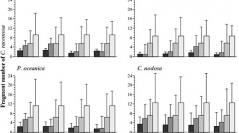

 Cryptogamie, Algologie
26 (3) - Pages 319-328
Cryptogamie, Algologie
26 (3) - Pages 319-328Caulerpa racemosa var. cylindracea was first recorded in the Mediterranean Sea in 1990 and its aggressive spread is now considered one of the most serious invasive events ever documented in the Mediterranean basin. The aim of this paper is to evaluate whether manual eradication of C. racemosa var. cylindracea is a feasible approach and if its success depends on the habitat. We performed removals of the alga from patches of different sizes in 4 habitats – C. racemosa var. cylindracea on rock, C. racemosa var. cylindracea mixed with Posidonia oceanica, C. racemosa var. cylindracea on P. oceanica dead ‘matte’, C. racemosa var. cylindracea mixed with Cymodocea nodosa – and evaluated the success of repeated manual removal efforts with controls where removal was performed only once. The abundance of Caulerpa racemosa var. cylindracea greatly decreased with removal efforts, but the presence of the alga was still detectable after 3 months of treatments in all habitats. After four removal efforts, tiny fragments of the alga still occurred in experimental patches and, due to its fast growth rate, the fragments could quickly recreate a patch like the one removed. These data suggest that the manual method on its own cannot be effective for removal of C. racemosa var. cylindracea. A combination of destructive methods of control, such as a mechanical scraping and the use of a benthic vacuum, may enhance the probability of success and result in the best habitat conservation.